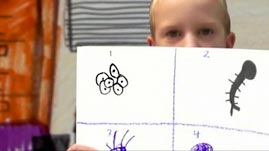Teachers' Domain - Digital Media for the Classroom and Professional Development
User: Preview


Source: Curious George, © 2006 Universal Studios. All rights reserved.
This video from Curious George introduces students to the life cycle of mosquitoes. The students in the video observe mosquitoes in their early stages of development—as larvae and pupae—in a typical breeding ground: a birdbath. They also have a chance to view adult mosquitoes under a microscope to learn which mosquito species are responsible for certain diseases.
Like butterflies and frogs, mosquitoes undergo a complete metamorphosis. They experience four distinct stages of development during a lifetime: egg, larva, pupa, and adult. A mosquito completes its life cycle in a few weeks to a month. Adult females lay between 40 to 400 tiny white eggs, typically on the surface of standing or slow-moving water. Prior to laying the eggs, the female mosquito seeks out protein from blood to help the eggs develop. The eggs of some mosquito species attach to one another and form a raft that enables them to float on the water together. Traveling in large numbers helps ensure survival of the species, as some of the eggs are eaten before they hatch.
Within a week, the eggs hatch into larvae—sometimes called "wrigglers." Larvae feed on floating organic matter, such as algae, and each other. They shed their skin four times as they grow to a half-inch in size. After the fourth molt, which takes place about 7 to 14 days after the eggs hatch, they reach the pupa stage. Pupae also live near the surface of the water. They breathe through tubes on their backs called siphons. Pupae do not eat. Instead, they rest inside their skincase, much like a cocoon, as they develop into adults. When disturbed, pupae dive in a tumbling motion before floating back to the surface. Hence their nickname: "tumblers."
The skincase splits after a few days, and an adult emerges to begin its terrestrial life. The reason mosquitoes need still water is because newly emerging adults need to stand on water for a few minutes to dry their wings and allow their body parts to harden before they can fly off. The adult lives for only a few weeks, so females begin to seek out animals to feed on just several days after emerging from the water.
Some types of mosquitoes are known to spread certain kinds of diseases to humans and animals, including birds and horses. Sometimes, these mosquito-borne diseases can even spread from animals to humans, as happens with Eastern equine encephalitis and West Nile virus. Scientists study mosquitoes to learn more about why disease spreads and how it might be controlled.
Because mosquitoes spend three of their four life stages in water, any sources of standing water are potential mosquito breeding grounds and should be cleared to keep populations down. This water can collect almost anywhere, including in tire swings, tin cans, flowerpots, and birdbaths. Because it takes 7 to 10 days for a mosquito egg to hatch and grow into an adult mosquito, removing any standing water around your home on a weekly basis will help prevent new eggs from hatching.
Mosquitoes are most active between dusk and dawn. To reduce your exposure to them, consider staying indoors during this time. When outdoors, cover your entire body and use insect repellants. Lastly, make sure that window and door screens fit tightly and are not torn.
 Loading Standards
Loading Standards Teachers' Domain is proud to be a Pathways portal to the National Science Digital Library.
Teachers' Domain is proud to be a Pathways portal to the National Science Digital Library.
